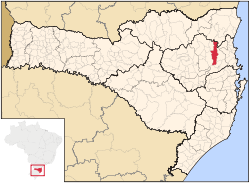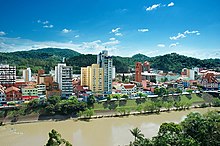Blumenau
Blumenau | |
|---|---|
 Blumenau and the Itajaí-Açu river | |
| Nickname: Cidade Jardim ("Garden City") | |
 Location in the state of Santa Catarina and Brazil | |
| Country | Brazil |
| Region | South |
| State | Santa Catarina |
| Founded | September 2, 1850 |
| Government | |
| • Mayor | João Paulo Kleinübing |
| Area | |
| • Total | 510 km2 (200 sq mi) |
| Elevation | 21 m (69 ft) |
| Population | |
| • Total | 309,214 |
| • Density | 59,483/km2 (154,060/sq mi) |
| Time zone | GMT-3 |
| Website | [1] |
Blumenau is a city in Vale do Itajaí, state of Santa Catarina, in southern Brazil. It was founded on September 2, 1850 by Dr. Hermann Bruno Otto Blumenau along with 17 German immigrants. A few years later Fritz Müller migrated to Blumenau as well.
Demographics
As of 2006, Blumenau had an estimated population of 302,000 people, with an area of 519 km². The main ethnic origin of the city inhabitants are German and Italian ancestries.[2] The city displays many historical and cultural reminders of their heritage, such as houses and other buildings built in a traditional German style, statues, and memorials.
Blumenau, compared to other Brazilian cities, has a high standard of living, with a Human Development Index of 0.855 as of 2000.[3]
"Racial" Composition
| Race/Skin color | Percentage | Number |
| Whites | 94.55% | 247,527 |
| Pardos (brown) | 3.50% | 9,171 |
| Blacks | 1.16% | 3,042 |
| Amerindians | 0.13% | 340 |
| Yellow (Asian) | 0.10% | 252 |
Religion
| Religion | Percentage | Number |
| Catholics | 73.90% | 193,474 |
| Protestants | 22.13% | 57,935 |
| No religion | 1.22% | 3,200 |
| Kardecists | 0.72% | 1,894 |
Geography and environment
The city is located in a valley bisected by the Itajaí-Açu River, surrounded by hills with forests. The lower areas, including towers and tall buildings in the city center, constantly suffer from the threat of floods. Blumenau's first recorded flood took place in the dawn on September 23, 1880. The worst took place in 1983 and 1984, when the city was completely isolated for weeks. Today, Blumenau is well-prepared against such threats, but many citizens prefer to live in higher areas spread into the nearby hills and plains to avoid flooding. However, this planning could not avoid an even worse flooding in late November 2008, killing over 100 and thousands evacuated.

Climate
| Blumenau | ||||||||||||||||||||||||||||||||||||||||||||||||||||||||||||
|---|---|---|---|---|---|---|---|---|---|---|---|---|---|---|---|---|---|---|---|---|---|---|---|---|---|---|---|---|---|---|---|---|---|---|---|---|---|---|---|---|---|---|---|---|---|---|---|---|---|---|---|---|---|---|---|---|---|---|---|---|
| Climate chart (explanation) | ||||||||||||||||||||||||||||||||||||||||||||||||||||||||||||
| ||||||||||||||||||||||||||||||||||||||||||||||||||||||||||||
| ||||||||||||||||||||||||||||||||||||||||||||||||||||||||||||
The climate of Blumenau is considered to be subtropical, a climate of transition between the predominantly tropical climate of Brazil and the predominantly temperate climate of Argentina. Under the Koppen climate classification, the city has a warm, humid subtropical climate.
Blumenau, like the entire state of Santa Catarina is located south of the Tropic of Capricorn; therefore it is mild in the winter with temperatures averaging 16.6°C (61°F) and warm and humid in the summer with temperatures averaging around 30°C (87°F).
Economy
Another area of focus is that of information technology, and the city the headquarters of the so-called Valley of the software, and many software leaders in its segment, some of whom were born in Blusoft and Instituto Gene, incubators of companies in the sector.
Its main economic activity is still the textile industry, responsible for large manufacturers such as Cia Hering, the Karsten and Teka.
Blumenau is also emphasized in other industrial sectors such as metallurgical, mechanical and electrical equipment, and is the largest producer of pole transformers in Brazil.
Has a strong economy, boosted by strong trade, service and tourism events, with exhibitions of international projection, which are generally held in German Village.
A new market, but expanding rapidly is the production of beer craft, such as Eisenbahn.
In 2005, the city has an export of products equivalent to U.S. $ 395,959,436.00, representing 6.1% of exports of the state.
Even though Blumenau has its own airport, normally passengers use scheduled flights operated from Ministro Victor Konder International Airport, located in the nearby municipality of Navegantes. Gol Airlines[6] and Azul Brazilian Airlines[7] offer for its passengers free bus transfers between Navegantes and Blumenau at regular times.
Tourism
The Secretariat of Tourism of Blumenau maintain 4 tour routes covering different aspects of the city. And besides these, another attraction is the festival of the municipality. Also, the Oktoberfest held every October attracts over a million tourists every year.
Divisions
Blumenau has 2 districts and 33 neighbourhoods:
|
Landmark dates
- The city was owned by its founder for 32 years, until it was emancipated on March 18, 1882.
- Blumenau was Brazil's first city to have public electrical lights in the streets. They started working on February 19, 1909.
- The city was divided in 1934, creating four new towns: Gaspar, Indaial, Timbó, and Dalbérgia (later renamed Ibirama).
- Cinema began in Blumenau in 1900. Radio arrived in 1935, and television in 1969.
- Teatro Carlos Gomes, the city's main theatre, was opened to the public in 1939.
- In 1956 the city's first major church opened. It was later rebuilt in 1963, with the addition of a bell tower.
- The city's most famous landmark is Moellman's Castle, a replica of the city hall of the German town of Michelstadt. It was inaugurated in 1978.
- The city's new city hall was inaugurated in 1982.
- Blumenau's first shopping center opened in 1994.
Famous inhabitants

- Theo Balden, sculptor and writer;
- Fritz Müller, biologist;
- Vera Fischer, actress;
- Mariana Weickert, model;
- Ana Moser, volleyball player.
- Rafael Schmitz, Lille OSC football player.
- Tiago Splitter, Professional basketball player (San Antonio Spurs contracted)
- Emílio Henrique Baumgart, architect
- Hermann Blumenau, founder of the city
- Evandro Goebel, soccer player
- Christian Maicon Hening, soccer player
- Lindolf Bell, writer
- Dennis Radünz, writer
- Urda Alice Klueger, writer
- João Geraldo Kuhlmann, botanist
- Jean Carlo Witte, soccer player
- Eduarda Amorim, handball player
- Ernst Robert Steinbach, co-founder of the well known Lojas Hering
- André Sá, professional tennis player
Sister city
See also
References
- ^ IBGE – Estimativas 2007 / Contagem da População 2007
- ^ Blumenau
- ^ "Ranking decrescente do IDH-M dos municípios do Brasil". Atlas do Desenvolvimento Humano. Programa das Nações Unidas para o Desenvolvimento (PNUD). 2000. Retrieved 11 de outubro de 2008.
{{cite web}}: Check date values in:|accessdate=(help) - ^ Sistema IBGE de Recuperação Automática - SIDRA
- ^ População residente por cor ou raça e religião/Município = Blumenau - SC/Cor ou raça = Total/Ano = 2000.
- ^ "Local Transportation-Navegantes". Gol Airlines. Retrieved 27 March 2011.
- ^ "Ônibus Executivo/Blumenau-Aeroporto de Navegantes" (in Portuguese). Azul Brazilian Airlines. Retrieved 27 March 2011.
External links
- City hall site
- Informational site for tourism and business people
- FURB - Universidade Regional de Blumenau, local university
- Oktoberfest/Blumenau (in Portuguese)
- German Genealogy: Brazil


